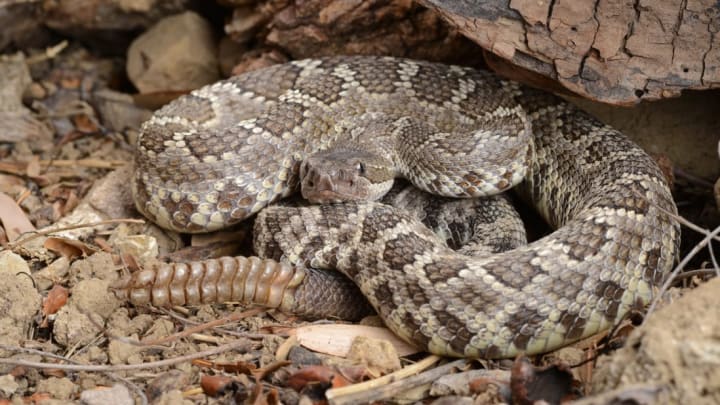12 Things You Should Know About Rattlesnakes
By Mark Mancini

Coiled defensively, its head reared and tail vibrating, a threatened rattlesnake commands respect. These venomous serpents have evolved one of nature’s most dramatic warning systems in their signature segmented rattles. But as we’ll see, their powerful bites are not the only thing rattlesnakes have going for them.
1. Rattlesnake scientific names refer to musical instruments.
All 36 species of rattlesnake are native to the Americas, with an overall range stretching from southern Canada to central Argentina and concentrated in the American Southwest. They can survive in all kinds of habitats where their prey—birds, rodents, amphibians, and other small animals—is plentiful. Rattlesnakes belong to two genera in the subfamily Crotalinae (the pit vipers): Crotalus, from the Greek word for castanet; and Sistrurus, invoking an ancient Egyptian musical instrument. Both genus names undoubtedly refer to the snakes’ characteristic rattles.
2. Venoms in rattlesnake bites are highly variable—even among members of the same species.
Each type of rattlesnake bite venom out there is an intricate cocktail loaded with different enzymes, toxins, and other compounds. Hemotoxins, which break down capillary walls and hinder blood circulation, are key ingredients in most of them. Neurotoxins, which attack the victim’s nervous system and cause seizures or paralysis, are another weapon. Venom composition can be extremely variable among individuals of the same species; for example, some timber rattlesnakes living in the American South have more neurotoxic venom than their northern counterparts do.
3. Rattlesnakes bite with movable fangs.
Cobras, mambas, and other snakes inject their venom into their victims through a pair of proteroglyphous, or fixed, fangs near the front of their mouths. Those snakes have to bite down and hang on to their prey to deliver the venomous punch. Rattlesnakes take a different approach. Like copperheads and Old World vipers, they have solenoglyphous fangs, which can actually swing forward and allow the rattlers to strike quickly, inject venom, and then back off. When the fangs aren’t being used, they’re pulled back and pressed against the roof of the snakes’ mouths.
4. Most rattlesnake bites are not fatal.
Rattlesnakes are the leading purveyor of venomous snakebites in North America. About 7000 to 8000 people are bitten each year, but thanks to effective antivenins, only five or six bites prove fatal.
5. Disembodied rattlesnake heads can still bite.
In 2018, a man in Corpus Christi, Texas found a western diamondback rattlesnake in his backyard and decapitated it with a shovel. Imagine his surprise when the head bit him on the hand. The man lived, but there have been cases of detached heads fatally envenomating people; the biting reflex in many venomous snakes remains active after the animal’s death.
6. The eastern diamondback rattlesnake is the largest venomous snake in North America.
Native to the southeastern U.S., the eastern diamondback can grow nearly 8 feet long and weigh more than 15 pounds. It’s the largest rattlesnake on Earth and the biggest venomous snake on the North American continent.
7. Rattlesnakes start growing rattles after their first shed.
Each rattlesnake is born with a nubby scale at the tip of its tail called a pre-button. After the snake’s first shed of their skin, the pre-button gets replaced with a button, a larger, hourglass-shaped scale. Later sheds add hollow, interlocking segments of keratin to the end of the tail. By vibrating the segments, the snakes create its distinctive rattling noise. Although it’s a myth that rattlesnakes must vibrate their tails before striking, they do use their rattles to warn approaching animals or people.
8. The number of rattle segments has nothing to do with the rattlesnake’s age.
A popular myth suggests that each rattle section represents a year in the animal’s life. In reality, a rattlesnake can shed multiple times, and gain multiple rattle segments, in a single year. Segments can also wear down and break off over time.
9. Rattlesnakes don’t lay eggs.
Like anacondas, rattlesnakes are ovoviviparous: They produce eggs that hatch inside their bodies and give birth to live, fully formed young. Depending on the species, a rattlesnake litter can include anywhere from one to 25 infants.
10. Not every rattlesnake species has a rattle.
Crotalus catalinensis, the Santa Catalina rattlesnake, has evolved to be rattle-free. It lives on Isla Santa Catalina, a small island in the Gulf of California. Although it belongs to the same genus as diamondbacks and timber rattlers, the snakes’ ancestors may have lost their appendages because there are fewer predators and big, trample-y mammals on the island to warn with menacing noises.
11. Rattlesnakes help plants by distributing seeds.
In a 2018 study, researchers looked into the guts of 50 dead rattlesnakes preserved at museums. They found 971 plant seeds that were likely carried by the rodents the snakes had eaten. When a rattlesnake devours some hapless mouse, the seeds it carried in its cheek pouches make their way through the snake’s digestive tract intact. By pooping out the seeds, the snakes help to restore plant growth in its habitat.
12. Benjamin Franklin admired timber rattlers.
Benjamin Franklin thought that rattlesnakes embodied uniquely American diplomacy and toughness. “She never wounds till she has generously given notice, even to her enemy, and cautioned him against the danger of stepping on her,” he wrote in a Pennsylvania newspaper in 1775. “Was I wrong, Sir, in thinking this a strong picture of the temper and conduct of America?”
He also noted that, like all snakes, timber rattlers don’t have eyelids, which made them naturally watchful. “She may therefore be esteemed an emblem of vigilance,” Franklin wrote.
Rattlesnakes later became symbols of America’s war for independence. Christopher Gadsden, a colonel from South Carolina, designed a personal flag to be flown on five ships belonging to the Continental Army. The bright yellow banner sported a coiled rattlesnake emblem and the caption “Don’t Tread on Me.” It remains popular among advocates of smaller federal government today.